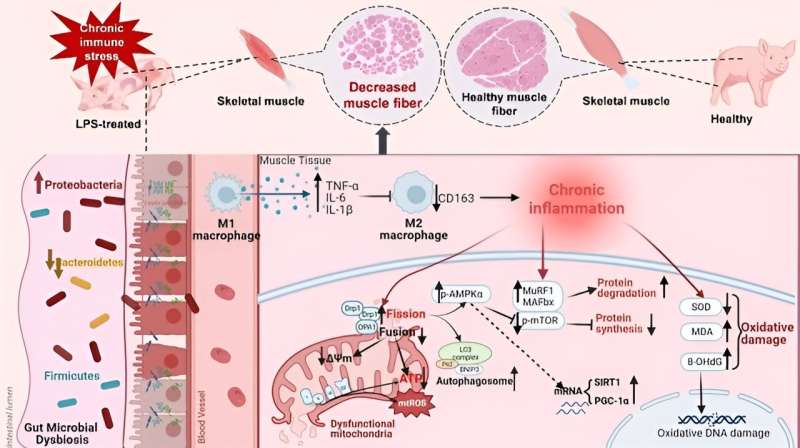This article has been reviewed according to Science X's editorial process and policies. Editors have highlighted the following attributes while ensuring the content's credibility:
fact-checked
peer-reviewed publication
trusted source
proofread
Scientists decode muscle loss in piglets

In a study published in Science China Life Sciences, Prof. Yin Yulong from the Institute of Subtropical Agriculture of the Chinese Academy of Sciences uncovered compelling evidence linking LPS-induced muscle mass loss with the reduction of Bacteroidetes abundance, increased inflammation, and disruption of mitochondrial morphology.
Using a lipopolysaccharide (LPS)-induced chronic immune stress piglet model, the researchers conducted an in-depth and series of experiments to examine the growth and developmental dynamics of intestinal, liver, and muscle tissues in immune-stressed weaned piglets.
Through extensive analysis, the researchers determined that inflammation plays a key role in the pathogenesis of skeletal muscle atrophy. Chronic inflammation is characterized by an imbalance between pro- and anti-inflammatory macrophages, leading to protein degradation and impaired muscle growth.
They highlighted that chronic immune stress resulted in a decrease in muscle mass and body weight that persisted even after 15 days. This observation contrasts with the initial liver and intestinal damage, which showed recovery in later phases. The main period during which muscle damage occurred was the early phase of stress (one to five days).
More interestingly, when the researchers analyzed the changes in the gut microbiota following LPS injection, a significant decrease in the relative abundance of Bacteroidetes was observed, accompanied by increased levels of pro-inflammatory cytokines.
The researchers then confirmed that mitochondrial dysfunction and morphological impairments were identified as key factors in muscle mass loss. Early mitochondrial changes preceded muscle weight loss in piglets, with significant changes in key mitochondrial dynamics proteins such as Drp1 and OPA1.
"These findings mark a significant advance in our understanding of muscle growth impairment in livestock and human health," said Prof Duan Yehui, corresponding author of the study. "Our data may provide potential therapeutic targets to prevent muscle mass loss."
Journal information: Science China Life Sciences
Provided by Chinese Academy of Sciences





















